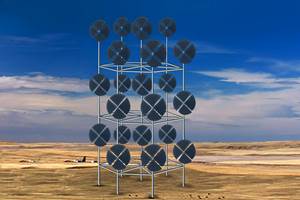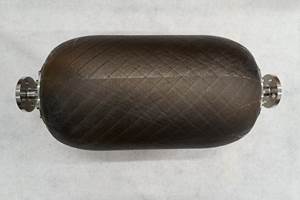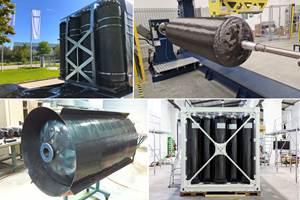The long view: DoE's offshore wind project funding
The U.S. Department of Energy raised some eyebrows when it chose not to fund UMaine's composites-intensive floating turbine, but perhaps the decision makes more sense than we realize.

UMaine's 1:8 scale VolturnUS floating turbine.
Journalists are “professional bystander.” At CompositesWorld, we get paid to watch the composites industry’s progress, and then write about it. For the most part, that means simply reporting what happens. We’re not experts (the last time I had hands on a composite layup was 1975), so we’re hardly entitled to preach. But we also believe that there’s no such thing as an innocent bystander. A journalist is responsible for reporting honestly what he or she sees, even when it might not reflect well on the community served.
So when the news came that the U.S. Department of Energy (DoE) had selected three pioneering offshore wind demonstrations to receive up to $47 million each over the next four years for deployment of innovative, grid-connected systems by 2017, we faced a quandary. The funded projects, located off the coasts of New Jersey, Oregon and Virginia were selected over the UMaine/DeepCWind Aqua Ventus floating wind turbine project. Aqua Ventus the fruit of a 10-year effort that Composites Technology (CT) magazine has followed almost from its inception, trailed in fourth position and, thus, missed the major funding
Welcome! You’ve unlocked premium content.
One of our own, who is on the ground in Maine, pointed at Governor Paul LePage. Noted for his obstinate resistance to wind energy development — he was specifically cited for blame when Norwegian energy company Statoil pulled out of a proposed $120 million offshore wind pilot project off the state’s coastline in 2013 — Maine’s top elected official was an easy target. But … maybe too easy.
Certainly, LePage is no friend to the clean energy endeavor, but I think it's important to take a step back and look at a broader picture. First, UMaine’s Aqua Ventus project was beat out for the third spot in the funding award by Principle Power's offshore concept, also a floating turbine system. Why this one? For one, the fact that Principle Power’s turbine will be supported on a relatively inexpensive steel tower anchored to a steel hull.
We cried foul there, too, because we all know that the best solution, regardless of its larger upfront expense, would be one in which composites figured. For 22 years, we’ve trumpeted the corrosion resistance, fatigue resistance and weight/mass advantages of composites and touted our key overarching argument: lifecycle cost. We’ve seen it proven repeatedly that the composite solution is the less-expensive option because it has a longer useful life and inevitably requires less maintenance. And nothing I say from here on changes that fact.
But the more important fact, for the moment, is this: Principle Power’s WindFloat system is a floater. Further, Principle Power’s prototype floating turbine foundation was put into deepwater and grid-connected off the coast of Portugal in October 2011, with a 2-MW Vestas turbine onboard (not the first, but the fourth such system). It was preceded by the Blue H rig, with an 80-kW turbine, fielded in 2007; the Hywind 2.3-MW floater in the North Sea, launched in September 2009; and one fielded by SeaTwirl off the coast of Sweden in 2011. UMaine/DeepCWind’s VolturnUS 1:8-scale floater, the subject of our Engineering Insights article in our upcoming CT June issue, is the fifth, and it supports a much smaller 20-kW turbine. And it was stationed of the coast of Maine much later than the others, in May 2013.
Here’s another fact: Principle Power’s floating turbine farm will be stationed offshore of Oregon. The deep waters off the West Coast (which is a bit longer than the coast of Maine) is, we must admit, an attractive target. Politics? Oh, yes. It's also a political decision to go with a technology that is likely to be cheaper in the short-run (Principle Powers') than UMaine's will be. Further, UMaine’s small-scale system is a long way from its production 6-MW system goal. That makes Principle Power's 2-MW system the closer-to-ready option, and more likely to populate a wind farm in a serious way by the anticipated 2017 DoE deadline.
The above are all political considerations (some good, some not-so-good) that might well have influenced the DoE’s choice regardless of Governor LePage's personal position and in spite of the fact that, in the long term, floaters with composite components certainly pose the better answer.
Speaking for myself, I'd love to see UMaine's floating turbine succeed. But truth is, I have questions about the choice of a concrete foundation. I have edited at least a dozen articles in the past decade that drew attention to the fact that concrete is big disappointment as an infrastructure material. Yes, it’s cheap. But its once-promised 100-year durability is, in practice, about 25 years. I lived in Pennsylvania for a bit, where winter temperatures hover slightly above and below freezing for weeks at a time, and they're lucky to get 15 years, there. Even in dry Colorado, where I now reside, we see crumbling concrete everywhere. So it puzzles me that concrete is the choice for a foundation that will be exposed 24/7 to a saltwater environment off the coast of Maine, where it will see extremes of weather Coloradans only read about.
As we prepared for our coming article on its laudable use of a composite tower on its floating turbine system, UMaine told us nothing at all about the VolturnUS concrete foundation, so it’s hard to know what they've conceived. But even if they use a new formulation, such as the "superhydrophobic" PLA-fiber-reinforced concrete that CT columnist Dale Brosius will discuss in his upcoming June “Composites: Perspectives & Provocations” column, I still wonder why they'd use that rather than something more like what the Navy is experimenting with for submarine “camels” — the huge concrete-ballasted floating composite structures that are tied to docks and provide a means to safely secure U.S. Navy subs in their berths. The composite protects the concrete ballast from exposure to saltwater, so the composite determines the system's useful life (see “Composite submarine camels win with long-term durability” | short.compositesworld.com/fU1KgKnR.) And if UMaine is using anything like conventional concrete, with steel rebar? "Fawgetaboudit," as they say. I can't be the only person on earth who is asking these questions. Unless those questions were answered to my satisfaction, I wouldn't feel comfortable choosing the UMaine concept just because it uses a composite tower.
Another point that must be kept in mind: Principle Power and UMaine are not comparable entites: Principle Power is a business. It's got investors and it has to make those investors their money back, with some profit. There is great pressure to produce results, and that fact influenced, no doubt, the company’s steel vs. composites choice. Principle Power could be as committed to composites as UMaine, in principle (I have it on good authority that they seriously considered composites). But when push comes to shove … well, at some point, they've got to pay the bills. Better sooner than later. (The American business landscape is littered with the carcasses of good business concepts that died because the investors’ money ran out before the profits began to roll in. The demise of composites up-and-comer Fiberforge is a good recent case in point. See “Fiberforge closes its doors, begins liquidation” | short.gardnerweb.com/FFshutdoor.)
UMaine is not a business. This academic institution will survive even if the Aqua Ventus doesn’t, because it hasn't got nearly as much skin in the game. That's not a bad thing. In fact, it's a good thing: UMaine’s team can afford to be idealists. That's why we want academics involved in product development. But if the history of composites tells us anything, it’s that resistance to change is, maybe, the number one political reality. It took 60 years for aluminum to displace wood in aircraft, and it's taking that long for composites to displace aluminum.
Good politicians recognize that public works advance best via baby steps. In that sense, they do take the long view. We have to keep in mind that the DoE's stated goal is to get technology up and running by 2017, not only to bolster power generation, but also to create jobs and investment opportunities. Given that, it's only natural that they'd look at projects that have a high probability of completion within the 2017 timeframe. Floating turbines with steel hulls and towers won't last, but they'll work. Steel hulls have taken ships around the globe for a couple of centuries. Steel towers have supported wind turbines successfully from their inception. Politicians will get U.S.-built floating turbines in the water and generating power and creating jobs. That's why idealists rarely make good politicians.
Good politicians also try real hard not to burn bridges. I’m told that at one point, UMaine and Principle Power were talking. Had an enduring collaborative dialog with the principals at Principle Power resulted, this story might have taken a different and, maybe, a far more encouraging turn. We'll never know. Somewhere along the line, the dialog ended. The academy went one way. The business went another.
Lifecycle cost can only be appreciated by those willing to look at things in the long term. But here, idealism must be tempered with realism. Our economic system, at present, almost requires front-loaded thinking. Those who make decisions are forced to emphasize short-term results at the expense of long-term benefit. Institutionalized self-sabotage. It's currently the American Way, but it's a pale perversion of what once was called the American Dream.
No, I’m not advocating that we abandon the free-market. Just saying that our vision of it in the U.S. is flawed. Everything here boils done to earnings per share. The quarterly report to the stockholders has displaced the Declaration of Independence and the U.S. Constitution in terms of practical importance. Meanwhile, those "command economies" we don't like so much are looking at us and learning: They'll field something that will last longer and require less maintenance because they really have other problems to solve. Shareholder profits there don’t outweigh the need for social solutions.
But the U.S. desperately needs to adopt a long-term perspective and seek the welfare of society as a whole. But that means that those who hold the purse strings will have to settle for less in the short term. How likely is that to happen in our current political climate where “welfare” and “social solutions” equal “socialism” — that well-worn epithet we heard flung about in recent electoral contests?
I'm sticking with the idea that this decision was primarily driven by politics (again, some good, some bad) that have very little to do with Governor LePage and selection of projects less lacking in “pioneering spirit” than our favorite, and a whole lot more to do with the DoE trying to play what it believes are the best cards in the not-nearly-perfect hand it's been dealt.
In any case, Aqua Ventus is not dead. The DoE awarded DeepCWind $3 million to complete its design. It also is the DoE’s first runner up. Should one of the three funded projects meet its demise, Aqua Ventus is the default. Notably, the project has a Power Purchase Agreement term sheet approved by the Maine Public Utilities Commission. That’s worth $240 million over 20 years.
My bet is that floating turbine farms with steel hulls and towers will be in the water first. They’ll be found wanting, and composite solutions, as they are scaled up to readiness with proven, full-scale technology — will be there when everybody finally gets the picture.
Related Content
Update: THOR project for industrialized, recyclable thermoplastic composite tanks for hydrogen storage
A look into the tape/liner materials, LATW/recycling processes, design software and new equipment toward commercialization of Type 4.5 tanks.
Read MoreDrag-based wind turbine design for higher energy capture
Claiming significantly higher power generation capacity than traditional blades, Xenecore aims to scale up its current monocoque, fan-shaped wind blades, made via compression molded carbon fiber/epoxy with I-beam ribs and microsphere structural foam.
Read MoreNCC reaches milestone in composite cryogenic hydrogen program
The National Composites Centre is testing composite cryogenic storage tank demonstrators with increasing complexity, to support U.K. transition to the hydrogen economy.
Read MoreComposites end markets: Pressure vessels (2024)
The market for pressure vessels used to store zero-emission fuels is rapidly growing, with ongoing developments and commercialization of Type 3, 4 and 5 tanks.
Read MoreRead Next
Developing bonded composite repair for ships, offshore units
Bureau Veritas and industry partners issue guidelines and pave the way for certification via StrengthBond Offshore project.
Read MoreAll-recycled, needle-punched nonwoven CFRP slashes carbon footprint of Formula 2 seat
Dallara and Tenowo collaborate to produce a race-ready Formula 2 seat using recycled carbon fiber, reducing CO2 emissions by 97.5% compared to virgin materials.
Read MoreVIDEO: High-volume processing for fiberglass components
Cannon Ergos, a company specializing in high-ton presses and equipment for composites fabrication and plastics processing, displayed automotive and industrial components at CAMX 2024.
Read More





















